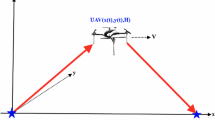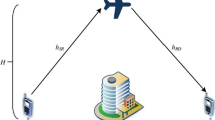Abstract
In this paper, we study the unmanned aerial vehicles (UAV) assisted relaying communication system, where a UAV acts the mobile relay and provides the information transfer from the source to the destination. The simultaneous wireless information and power transfer techniques are considered at the UAV relays, where the UAV harvests energy from the source node, and exclusively uses the harvested energy for the data relaying. To maximize the system throughput, we jointly consider the UAV trajectory optimization and resource allocation problem, where the UAV trajectory is optimized the UAV positions to harvest the benefits of the line-of-sight links, and resource allocation, including power allocation and the subcarrier allocation, is used to achieve optimal network performance with the power constraints. An alternating maximization algorithm is proposed to solve the optimization problem, in which the UAV trajectory optimization and resource allocation are solved iteratively to maximize the total throughput. Compared with other benchmarks, the proposed algorithm can achieve higher throughput by the benefits from UAV trajectory optimization and resource allocation.





Similar content being viewed by others
References
Hayat, S., Yanmaz, E., & Muzaffar, R. (2016). Survey on unmanned aerial vehicle networks for civil applications: A communications viewpoint. IEEE Communications Surveys & Tutorials, 18(4), 2624–2661.
Zeng, Y., Zhang, R., & Lim, T. J. (2016). Wireless communications with unmanned aerial vehicles: Opportunities and challenges. IEEE Communications Magazine, 54(5), 36–42.
Liu, B., Zhu, Q., & Zhu, H. (2018). Delay-aware LTE WLAN aggregation in heterogeneous wireless network. IEEE Access, 6, 14544–14559.
Zhan, P., Yu, K., & Swindlehurst, A. L. (2011). Wireless relay communications with unmanned aerial vehicles: Performance and optimization. IEEE Transactions on Aerospace and Electronic Systems, 47(3), 2068–2085.
Zhao, N., Lu, W., Sheng, M., Chen, Y., Tang, J., Yu, F. R., et al. (2019). UAV-assisted emergency networks in disasters. IEEE Wireless Communications, 26(1), 45–51.
Liu, B., & Zhu, H. (2019). Energy-effective data gathering for UAV-aided wireless sensor networks. Sensors, 19(11), 2506.
Zhang, G., Yan, H., Zeng, Y., Cui, M., & Liu, Y. (2018). Trajectory optimization and power allocation for multi-hop UAV relaying communications. IEEE Access, 6, 48566–48576.
Chen, Y., Feng, W., & Zheng, G. (2018). Optimum placement of UAV as relays. IEEE Communications Letters, 22(2), 248–251.
Chen, J., & Gesbert, D. (2017). Optimal positioning of flying relays for wireless networks: A LOS map approach. In Proceedings of IEEE International Conference on Communications (ICC) (pp. 1–6). Paris, France
Zeng, Y., Zhang, R., & Lim, T. J. (2016). Throughput maximization for UAV-enabled mobile relaying systems. IEEE Transactions on Communications, 64(12), 4983–4996.
Zeng, Y., Xu, X., & Zhang, R. (2018). Trajectory design for completion time minimization in UAV-enabled multicasting. IEEE Transactions on Wireless Communications, 17(4), 2233–2246.
Zeng, Y., & Zhang, R. (2017). Energy-efficient UAV communication with trajectory optimization. IEEE Transactions on Wireless Communications, 16(6), 3747–3760.
Mozaffari, M., Saad, W., Bennis, M., & Debbah, M. (2017). Wireless communication using unmanned aerial vehicles (UAVs): Optimal transport theory for hover time optimization. IEEE Transactions on Wireless Communications, 16(12), 8052–8066.
Cheng, F., Zhang, S., Li, Z., Chen, Y., Zhao, N., Yu, F. R., et al. (2018). UAV trajectory optimization for data offloading at the edge of multiple cells. IEEE Transactions on Vehicular Technology, 67(7), 6732–6736.
Chen, Y., Zhao, N., Ding, Z., & Alouini, M. S. (2018). Multiple UAVs as relays: Multi-hop single link versus multiple dual-hop links. IEEE Transactions on Wireless Communications, 17(9), 6348–6359.
Alsharoa, A., Ghazzai, H., Yuksel, M., Kadri, A., & Kamal, A. E. (2018). Trajectory optimization for multiple UAVs acting as wireless relays. In Proceedings of IEEE International Conference on Communications Workshops (ICC Workshops) (pp. 1–6). Kansas City, USA
Cheng, F., Gui, G., Zhao, N., Chen, Y., Tang, J., & Sari, H. (2019). UAV-relaying-assisted secure transmission with caching. IEEE Transactions on Communications, 67(5), 3140–3153.
Zhao, N., Cheng, F., Yu, F. R., Tang, J., Chen, Y., Gui, G., et al. (2018). Caching UAV assisted secure transmission in hyper-dense networks based on interference alignment. IEEE Transactions on Communications, 66(5), 2281–2294.
Jie, X., Yong, Z., & Rui, Z. (2018). UAV-enabled wireless power transfer: Trajectory design and energy optimization. IEEE Transactions on Wireless Communications, 17(8), 5092–5106.
Jeong, S., Bito, J., & Tentzeris, M. M. (2017). Design of a novel wireless power system using machine learning techniques for drone applications. In Wireless Power Transfer Conference (WPTC) (pp. 1–4). Kansas City, USA
Yin, S., Zhao, Y., & Li, L. (2018). UAV-assisted cooperative communications with time-sharing SWIPT. In Proceedings of IEEE International Conference on Communications (ICC) (pp. 1–6). Kansas City, USA
Zhou, X., Ho, C. K., & Zhang, R. (2016). Wireless power meets energy harvesting: A joint energy allocation approach in OFDM-based system. IEEE Transactions on Wireless Communications, 15(5), 3481–3491.
Kim, H., Lee, H., Ahn, M., Kong, H. B., & Lee, I. (2016). Joint subcarrier and power allocation methods in full duplex wireless powered communication networks for OFDM systems. IEEE Transactions on Wireless Communications, 15(7), 4745–4753.
Xiong, K., Fan, P., Zhang, C., & Letaief, K. B. (2015). Wireless information and energy transfer for two-hop non-regenerative MIMO-OFDM relay networks. IEEE Journal on Selected Areas in Communications, 33(8), 1595–1611.
Li, C., Yang, H. J., Sun, F., Cioffi, J. M., & Yang, L. (2015). Multiuser overhearing for cooperative two-way multiantenna relays. IEEE Transactions on Vehicular Technology, 65(5), 3796–3802.
Li, C., Zhang, S., Liu, P., Sun, F., Cioffi, J. M., & Yang, L. (2016). Overhearing protocol design exploiting intercell interference in cooperative green networks. IEEE Transactions on Vehicular Technology, 65(1), 441–446.
Li, C., Liu, P., Zou, C., Sun, F., Cioffi, J. M., & Yang, L. (2016). Spectral-efficient cellular communications with coexistent one-and two-hop transmissions. IEEE Transactions on Vehicular Technology, 65(8), 6765–6772.
Liu, B., & Zhu, H. (2018). Rotman lens-based two-tier hybrid beamforming for wideband mmWave MIMO-OFDM system with beam squint. EURASIP Journal on Wireless Communications and Networking, 2018(1), 267.
Xie, Z., Zhu, Q., & Zhao, S. (2017). Resource allocation algorithm based on simultaneous wireless information and power transfer for OFDM relay networks. KSII Transactions on Internet & Information Systems, 11(12), 5943–5962.
Liu, B., Zhu, Q., Tan, W., & Zhu, H. (2018). Congestion-optimal WiFi offloading with user mobility management in smart communications. Wireless Communications and Mobile Computing, 2018, 1–15.
Wu, Q., Yong, Z., & Rui, Z. (2018). Joint trajectory and communication design for multi-UAV enabled wireless networks. IEEE Transactions on Wireless Communications, 17(3), 2109–2121.
Zhan, C., Zeng, Y., & Zhang, R. (2018). Energy-efficient data collection in UAV enabled wireless sensor network. IEEE Wireless Communications Letters, 7(3), 328–331.
Acknowledgements
The work of B. Liu, Q. Zhu, and H. Zhu was supported in part by the National Natural Science Foundation of China (61871446, 61971239, 61701201, 61427801), and in part by the Postgraduate Research & Practice Innovation Program of Jiangsu Province under Grants (KYCX18_0893). The work of B. Liu was also supported in part by the Natural Science Foundation of Jiangsu Province (No. BK20170758) and in part by the China Scholarship Council.
Author information
Authors and Affiliations
Corresponding author
Ethics declarations
Conflict of interest
The authors declare that they have no conflict of interest.
Additional information
Publisher's Note
Springer Nature remains neutral with regard to jurisdictional claims in published maps and institutional affiliations.
Appendices
Appendix 1
Proving by contradiction, for the optimal power allocation scheme \(\{p_n^{a*}[m]\}\) and \(\{p_n^{b*}[m]\}\), we have opposite proposition as
Then, we have
Then, we reduce the transmit power at the source \(\{p_n^{a*}[m]\}\), or reduce the SCs amount in \(\mathbf {N}_I\) until
where (20) still holds. In fact, the reduction of transmit power for information at the source is equal to increasing the power for relaying. Namely, when (19) holds, the power allocation at transmit \(\{p_n^{a*}[m]\}\) is not optimal, which is contradicted with the proposition. Thus, the assumed proposition (19) is not true, and then we complete the proof.
Appendix 2
Proving it by contradiction, we have
- (a)
\(\exists u \in [1,n)\) satisfies \(0 \le p_{\kappa (u)}^{a*}< P_{\text {max}}\);
- (b)
\(\exists u \in (n, {|\mathbf {N}_E|}]\) satisfies \(0 \le p_{\kappa (u)}^{a*}< P_{\text {max}}\);
We give the proof of case (a) and similar approach can be applied to case (b). For \(\forall u, 0< u < n\), and we have \(h^{\kappa (z)}_{s,u} \ge h^{\kappa (n)}_{s,u}\). Let denote
where \(\bar{p}_{\kappa (z)}^{a}\) and \(\bar{p}_{\kappa (n)}^{a}\) are feasible for the constrain in the problem P1, and we have
Clearly, UAV harvest more energy if the power allocation \(\bar{p}_{\kappa (z)}^{a}\) and \(\bar{p}_{\kappa (n)}^{a}\) are taken at the source than these under \({p}_{\kappa (z)}^{a*}\) and \({p}_{\kappa (n)}^{a*}\). Assume the inequation (24) holds when \(\bar{p}_{\kappa (u)}^{a}= \bar{p}_{\kappa (u)}^{a}- \tau\), \(\tau >0\), and \(\tau\) energy is reallocated for information transfer at the source while the information throughput between UAV and destination is non-decreasing by this reallocation. Thus, higher throughout can be achieved with \(\bar{p}_{\kappa (z)}^{a}\) and \(\bar{p}_{\kappa (n)}^{a}\) than the optimal power allocation scheme \(\{{p}_{\kappa (z)}^{a*}\}\) and \(\{{p}_{\kappa (n)}^{a*}\}\), which is contradicted the case (a). Similarly, we can induce the contradiction in case (b). Then, it completes the proof.
Rights and permissions
About this article
Cite this article
Liu, B., Zhu, Q. & Zhu, H. Trajectory optimization and resource allocation for UAV-assisted relaying communications. Wireless Netw 26, 739–749 (2020). https://doi.org/10.1007/s11276-019-02178-1
Published:
Issue Date:
DOI: https://doi.org/10.1007/s11276-019-02178-1




